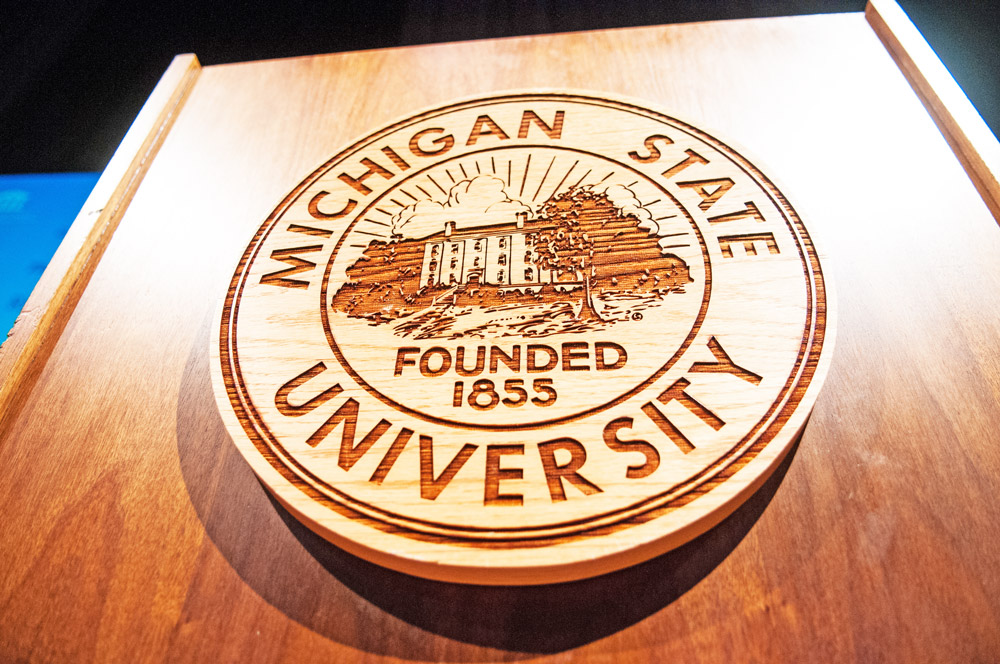Four outstanding instructors for online and blended courses were selected as recipients of the 2017 MSU AT&T Faculty-Staff Awards in Instructional Technology.
“The AT&T Awards provide a venue for MSU to recognize outstanding faculty and staff whose innovation and creativity inspire others in new ways of using technology in instruction,” said Severin Grabski, lead judge for 2017 AT&T Awards; associate professor in the Department of Accounting & Information Systems, College of Business; and senior faculty advisor to the CIO of MSU.
2017 AT&T Faculty-Staff Awards in Instructional Technology Winners
Best Online Course
Cathleen McGreal – PSY 320, Health Psychology
PSY 320 is a large-enrollment course, offered both face to face and online. It focuses on “Social, psychological, and biological factors affecting health, illness, and use of health services” as well as “stress and coping processes, lifestyles, and illness management.” The course was designed based on Universal Design for Learning (UDL) principles, as a means of ensuring that all students would have an equal and equivalent learning experience in the course.
Working within the UDL framework, students were required to include a “Cartoon Composition” section in the paper that gave a cell by cell description of the cartoon in detail. The purpose of this paragraph was to allow students who were visually impaired to provide feedback for their teammates.
According to McGreal, “A plan for cartoon creation by visually impaired students was also in place. Although no students needed this accommodation, the inclusion of this section proved useful to me, an aspect of UDL design that I hadn’t anticipated. There were often aspects of a cartoon that had been carefully planned by the learner that I hadn’t picked up on!”
Honorable Mentions
Dustin DeFelice – FLT 881, Teaching Foreign Language with Technology
This course focused on the current situation with the ever-changing face of technology in language teaching and points students in the direction of a new worldview in terms of how technology plays a role in language acquisition and teaching. The collaborative and constructivist nature of this course led to a very useful application of the online tool Padlet.
From a student: “I love that this class has given me a lot of new ways to integrate technology into my classroom. The readings are so practical. I really enjoyed reading about the technology toolbelt chapters.”
Tina Blaschke-Thompson – SW 491, Combat Veterans: The Physical, Emotional, and Social Costs of War
“Combat Veterans: The Physical, Emotional, and Social Costs of War” is an online 2-credit elective course designed to increase awareness and deepen empathy for the experiences of those who have fought in our nation’s wars. Organized around the military deployment cycle, students get to know the veterans by journeying with them as the weeks unfold, starting with how and why the veteran enlisted, what boot camp was like, their experience of war, and ending with the challenges they faced transitioning back to civilian life.
Best Blended/Hybrid/Flipped Course
Kathleen Hoag, BLD 424, Clinical Immunology
BLD 434 has been taught in a flipped format since fall semester 2012 and used D2L heavily. Students use D2L to view recorded closed-captioned lectures prior to class. Students are asked to focus on assigned learning objectives when watching the lecture recordings, and individually prepare the best written response to each objective prior to class.
Most class sessions have review iClicker questions at the beginning of class and end with iClicker questions over the new content. Students are prompted to discuss any iClicker questions in which <60% of students answer correctly, and given the opportunity to answer the question again. The class was designed with accessibility in mind, with recorded closed-captioned lectures. Students report that they appreciate and utilize the closed-captioning.
Hoag said: “It is especially important to aid students who have hearing impairment or for who English is not their first language, but it is also used by many other students who would not be expected to have a language barrier.”
Honorable Mention
Paul Irving, PHY 183, Physics for Scientists and Engineers
Projects and Practices in Physics (P^3) is an introductory physics course for engineering and science majors that focused on mechanics. The primary descriptor of the class is that it is a flipped, group based project-based learning class. No in-class time is devoted to delivering material via lectures. Traditional textbooks were replaced with a wiki filled with resources.
One of the of the key computational learning goals for the class is for students to understand iterative integration loops and how those loops can be employed to create model and visualize bodies in motion. For example, in one of these programs (created with VPython) that students interpret and adapt, they have to model the motion of a hovercraft falling off a cliff and use their computational model to make predictions as to where the components will fall.
“Overall, as a student who came into this class with no former physics knowledge and a general distaste for the subject, this experience left me with a profound understanding of the topics covered and a passion for what I had learned. This class helped me be more comfortable in a group setting and more confident in my individual understanding of the physics.”
Best Technology Enhanced
Brad Willcuts, DAN 352, Dance Technique II (Contemporary Dance)
DAN 352 is a dance techniques-based class in which the student learns a kinesthetic approach to multiple forms of dance in the contemporary cannon. The student is assessed by their growth in the class, retention of choreographic styles and ability to expand artistically. To facilitate this growth, the class was supplemented by live-streaming dance classes from Los Angeles with top professional dancers from So You Think You Can Dance and CLI Studios. By using professional dancers to supplement classes, the students learned from the absolute pinnacle of contemporary dance knowledge.
Willcuts worked with Teddy Forance, co-founder of CLI Studios, to create an online learning experience solely for MSU students. This project was then used to create CLI Studios’ new Live-Class program, which is used by thousands of students all over the world. Students appreciated the opportunity to learn from famous, noted experts in the field.
One student explained: “I really enjoyed having the opportunity to have Teddy join us via a virtual environment. His instruction was of such high quality that even over a Skype call his ideas were translatable and we were able to embody his choreography. These experiences open performers up to so many more chances to learn different styles and make lasting connections that could make a tremendously positive impact on one’s career…Technology allowed us to both experience a new way of moving and make a fantastic, marketable product. As a student, I think technological advances are so important to integrate in order to allow the classroom setting to become much more experimental and stand out from a traditional learning model.”
Honorable Mention
Christine Greenhow, CEP 956, Mind, Media, and Learning
Drawing on an interdisciplinary, emerging base of research and students’ experiences, CEP 956 “Mind, Media & Learning” took a critical and informed approach to evaluating contemporary online and social media practices for teaching and learning. The course explores the psychology and sociology of new media; media effects and learning with media; issues of identity, literacy, and culture in technologically mediated environments; and the reciprocal relationship between educational psychology and educational technology.
Most importantly, the course is designed to help students debate current issues and develop their research interests to situate their work in the field. Greenhow sought out robot technology to bring together individuals physically present and those who are online. In partnership with a colleague in the College of Education’s Design Studio (William Cain), the accessibility specialist in the Resource Center for Persons with Disabilities (Ginger Martz), and two ASL interpreters, Greenhow invstigated students’ experiences of social presence and embodiment in robot-mediated compared to videoconferencing communication. This helped her understand better how to improve the overall quality of the synchronous class discussion, especially for students with auditory disabilities and their tutors.
AT&T Awards background
MSU established the AT&T Instructional Technology Awards program in 2005, through a gift from AT&T (then SBC). The award program is administered by the Office of the CIO and MSU Information Technology.
Since its inception, 63 instructional technology innovations in MSU courses have received this award.



